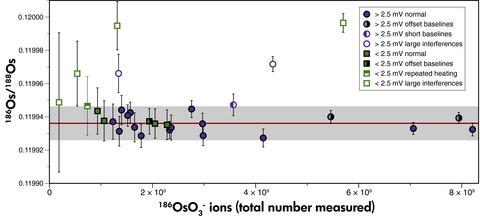当前位置:
X-MOL 学术
›
Geostand. Geoanal. Res.
›
论文详情
Our official English website, www.x-mol.net, welcomes your feedback! (Note: you will need to create a separate account there.)
Optimisation of 186Os/188Os Measurements by N‐TIMS Using Amplifiers Equipped with 1013 Ω Resistors
Geostandards and Geoanalytical Research ( IF 3.8 ) Pub Date : 2020-12-06 , DOI: 10.1111/ggr.12371 Laurie Reisberg 1 , Catherine Zimmermann 1
Geostandards and Geoanalytical Research ( IF 3.8 ) Pub Date : 2020-12-06 , DOI: 10.1111/ggr.12371 Laurie Reisberg 1 , Catherine Zimmermann 1
Affiliation

|
Analysis of 186Os/188Os variations in most natural samples is hampered by their low Os mass fractions (usually < 100 pg g−1), requiring Os separation from up to a kilogram of powder to obtain high precision measurement results. Recently developed amplifiers equipped with 1013 Ω feedback resistors improve the signal to noise ratio by an order of magnitude, allowing acquisition of high precision data (2SE < 50 ppm) from 186Os16O3− ion beams of ~ 40 fA and thus analysis of less material (~ 10–500 g). Factors controlling the uncertainty of 186Os/188Os N‐TIMS measurement results, using a mixed array of 1013 and 1011 Ω amplifiers, include isobaric interferences, baseline variability, gain calibration, decay time corrections and oxygen isotope composition variations. Isobaric interferences present the greatest challenges, but these can be largely overcome by using double Pt filaments and periodically monitoring interferences during each measurement. The optimised procedures produce 186Os/188Os ratios with precisions close to the theoretical limits imposed by counting statistics and Johnson–Nyquist electronic noise for ion beams of 10–70 fA. The intermediate measurement precision (85 ppm; 2s) approaches theoretically expected values (~ 50–80 ppm). This precision is sufficient to allow 186Os/188Os analyses of crustal rocks, for which relatively large variations are expected.
中文翻译:

使用配备1013Ω电阻的放大器通过N‐TIMS优化186Os / 188Os测量
低天然质量分数(通常<100 pg g -1)阻碍了大多数天然样品中186 Os / 188 Os变异的分析,需要从高达一公斤的粉末中分离出Os才能获得高精度的测量结果。配备了10个最近开发的放大器13 Ω反馈电阻改善一个数量级的信噪比,从允许采集高精度的数据(2SE <50ppm的)的186 O的16 ö 3 -离子束〜40的FA和由此分析更少的材料(约10–500克)。控制186 Os / 188不确定度的因素OS的N- TIMS测量结果,使用10个的混合阵列13和10 11 Ω放大器,包括同量异位的干扰,基线变异性,增益校准,衰减时间校正和氧同位素组成的变化。等压干扰是最大的挑战,但是可以通过使用双Pt灯丝并在每次测量期间定期监视干扰来克服这些挑战。经过优化的程序可产生186 Os / 188 Os的比率,其精度接近通过对10–70 fA的离子束进行统计统计和Johnson-Nyquist电子噪声所施加的理论极限。的中间测量精度(85ppm的; 2个小号)接近理论上的预期值(约50–80 ppm)。这种精度足以允许对地壳岩石进行186 Os / 188 Os的分析,因此预计会有较大的变化。
更新日期:2020-12-06
中文翻译:

使用配备1013Ω电阻的放大器通过N‐TIMS优化186Os / 188Os测量
低天然质量分数(通常<100 pg g -1)阻碍了大多数天然样品中186 Os / 188 Os变异的分析,需要从高达一公斤的粉末中分离出Os才能获得高精度的测量结果。配备了10个最近开发的放大器13 Ω反馈电阻改善一个数量级的信噪比,从允许采集高精度的数据(2SE <50ppm的)的186 O的16 ö 3 -离子束〜40的FA和由此分析更少的材料(约10–500克)。控制186 Os / 188不确定度的因素OS的N- TIMS测量结果,使用10个的混合阵列13和10 11 Ω放大器,包括同量异位的干扰,基线变异性,增益校准,衰减时间校正和氧同位素组成的变化。等压干扰是最大的挑战,但是可以通过使用双Pt灯丝并在每次测量期间定期监视干扰来克服这些挑战。经过优化的程序可产生186 Os / 188 Os的比率,其精度接近通过对10–70 fA的离子束进行统计统计和Johnson-Nyquist电子噪声所施加的理论极限。的中间测量精度(85ppm的; 2个小号)接近理论上的预期值(约50–80 ppm)。这种精度足以允许对地壳岩石进行186 Os / 188 Os的分析,因此预计会有较大的变化。



























 京公网安备 11010802027423号
京公网安备 11010802027423号